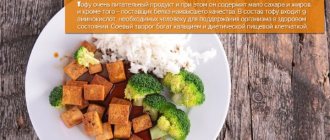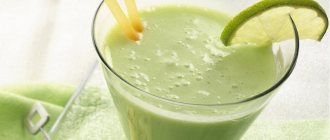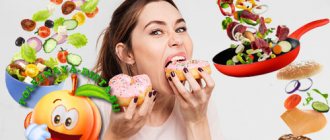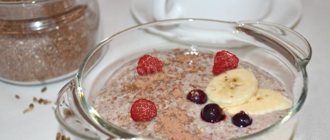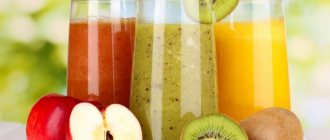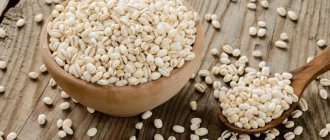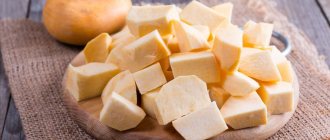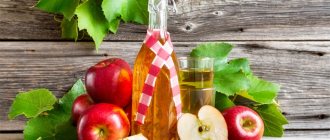During pregnancy, a woman tries to do everything to get as many nutrients as possible from food, which are extremely necessary not only for the child, but also for the mother herself. For this purpose, it is necessary to systematically introduce not only whole vegetables and fruits into the diet, but also various salads. In particular, many are interested in whether such a popular salad as vinaigrette is healthy, and if so, how best to prepare it.
- Can pregnant women eat vinaigrette? Benefits
- Contraindications and harm
Diet, menu for pregnant women
The menu of the expectant mother is exactly the factor that can radically affect the physical and mental health of the baby.
Therefore, the diet during pregnancy should be calculated from the perspective of its influence on the formation and development of the fetus. A pregnant woman needs to make adjustments to her diet. The uterus enlarges and begins to put pressure on the internal organs, including the stomach and intestines, so it is better for the expectant mother to eat little by little and more often. Replace daily three meals a day with 4-5 meals a day, and in the second half of pregnancy with 5-7 meals a day. Try to distribute foods between meals so that in the first half of the day you eat mainly fish, meat, and cereals. Leave dairy and plant products for the evening.
The last meal should be at least two hours before bedtime. When creating a menu for a pregnant woman, you should first of all be guided by other general dietary recommendations. Eliminate fatty, fried, smoked, spicy, salty, sour, pickled and canned foods from the diet - all this, one way or another, overloads the liver and gall bladder.
If you also study special literature, you may get the impression that you can’t eat practically anything, and only porridge and low-fat yogurt can live in a pregnant woman’s kitchen. However, it should be clearly remembered: there is no such product, a single use of which in moderate quantities could have a detrimental effect on the course of pregnancy or the condition of the fetus.
Of course, there is a group of foods and cooking methods that are best either completely excluded from the diet during pregnancy, or eaten occasionally, in minimal quantities. Thus, coffee and wine contribute to increased blood pressure, which is undesirable for the expectant mother. Beer and pickles increase the load on the kidneys, which during pregnancy already work for “two people”. In general, alcohol, especially in large quantities, can negatively affect the formation of the baby’s organs and systems.
In addition, it is advisable for expectant mothers who are prone to allergic reactions or who have close relatives with allergies to remove chocolate, citrus fruits, strawberries, exotic fruits, seafood, and nuts from their diet. What remains? You can and should include greens, vegetables and fruits, almost everything (excluding allergens) in a pregnant woman’s diet. They must be consumed raw or heat-treated. These are, as a rule, main courses and salads, which are best seasoned with unrefined vegetable oil.
Berries - cranberries, lingonberries, rose hips, blueberries, currants, chokeberries - are the main helpers of the expectant mother's kidneys and a source of vitamin C. The berries are good fresh, pureed with sugar, boiled, in the form of fruit drinks, compotes, jelly.
Porridge is an ideal breakfast for a pregnant woman. Buckwheat, millet, corn and oat porridge contain iron, carbohydrates, vitamins, and fiber. It is better to cook them in water, and add oil a few minutes before they are ready. You can add dried fruits to sweet porridges, and various sautéed vegetables to salty porridges.
Muesli is no less useful - a simple ready-made vitamin cocktail, and quite high in calories. Muesli can be eaten with fruit juice, milk, kefir, and yogurt. By the way, dairy products, both fresh and fermented milk, are the main source of calcium - you can’t do without them.
And meat serves as the main source of animal protein, B vitamins and iron. It is better to buy chilled meat rather than frozen, it retains its beneficial qualities better. For meat snacks, give preference to low-fat ham and boiled pork. But it is advisable to abstain from sausage products; they contain too much fat and preservatives.
Fish. This product contains vitamin D and phosphorus, which are responsible for the functioning of the child’s nervous system. Try to include fresh, low-fat fish in your diet (cod, perch, pollock, ice fish, hake).
Diet for pregnant women by trimester of pregnancy
In the first trimester, the body experiences adaptation to a new state. During this period, the fetus practically does not need to increase the calorie content of your diet. Moreover, the excess weight that you will struggle with in the postpartum period, as a rule, women gain in the first 12 weeks of pregnancy. Therefore, you should not listen to grandmothers who unanimously repeat: “Eat for two!”
In this trimester, all the baby’s systems are formed, and the main emphasis should be on the quality of food. The basis of the diet should be proteins and vitamins. Daily diet – no more than 2000 kcal. Do not limit yourself to fresh fruits, vegetables, herbs, juices. It is better to replace wheat bread with rye or bran bread. In the first weeks of pregnancy, protein accumulates in the mother’s body as a “building material” for the unborn child. Bones and tissues will begin to form later, but it is better to make a reserve now.
The second trimester is a time of active fetal growth. During this period, the mother’s body requires additional feeding: the daily ration increases to 2500 kcal. But this should not be done at the expense of sugar. Starting from 14 weeks of pregnancy, limit the consumption of confectionery, sweets, and jam to 40-50 g per day. The diet includes up to 40% fats of vegetable origin. They are part of the structure of all tissues and help the body absorb fat-soluble vitamins (A, F, K, D). From vegetable oils, choose any oil, consume up to 2 tablespoons per day. But it’s better to avoid animal fats (butter, cream, sour cream) for now.
In this trimester, the role of vitamins does not weaken. Thus, with a lack of vitamin D in a woman’s body, the fetus develops the bone skeleton worse, which increases the risk of rickets, and vitamin E affects bone growth. Vitamins “come” into our body with food. Vitamin B is contained in products made from wholemeal flour, bran, uncrushed cereals, legumes, potatoes, fruits, eggs, liver, meat, cottage cheese, and butter.
There is a lot of vitamin A in carrots, but it is absorbed only together with fats. Pour vegetable oil over the carrots, and your body will receive an additional portion of vitamin E. Calcium, from low-calorie foods, is most abundant in milk, low-fat cheese, and low-fat cottage cheese. Milk should be consumed separately from other foods and drunk in small sips - this way the calcium contained in it is better absorbed.
The benefits and harms of vinaigrette for the body, calorie content and use in diets
A popular vegetable salad called vinaigrette has a fairly low calorie content. The amount of calories, as well as proteins, fats and carbohydrates, increases with the addition of new components (for example, herring). This dish is extremely beneficial for the health of men and women (in particular, for pregnant women).
Vinaigrette can be eaten by people who want to lose weight. But if you use the dish incorrectly, there is a risk, on the contrary, of gaining weight.
The classic vinaigrette has a calorie content of 82.9 kcal . Nutritional value of the dish (content of proteins, fats and carbohydrates): 1.7/4.7/8.5 g.
An average serving of salad contains 120 g, which equals 135.53 kcal. BJU ratio: 2.12/6.97/9.74 g.
The calorie content of a dish per 100 grams varies depending on the ingredients specified in the recipe:
| Type of vinaigrette | Number of calories (kcal) | BZHU (g) |
| With vegetable oil and potatoes | 57,2 | 1,7/1,4/9,7 |
| With potatoes, butter and green peas | 71,8 | 2,1/3,6/8 ,2 |
| With cucumber and peas | 47,1 | 2/0,2/9,4 |
| Vegetable without oil | 35,8 | 1,5/0,2/7,5 |
| With sauerkraut | 53,2 | 1,4/1,9/7,9 |
| With potatoes, butter and beans | 54,3 | 1,7/2,6/5 ,9 |
| No legumes (peas and beans) | 46 | 1/1/8 |
| With beets and other vegetables | 61,4 | 2,3/2,4/8 ,7 |
| With herring | 116,1 | 6,4/7,1 /6,6 |
| With egg and mayonnaise | 108,6 | 4,7/6,5/7,7 |
| With mushrooms | 124,75 | 3,44/5,30/15,1 |
| With olive oil | 82,50 | 1,6/4,85/8,4 |
The most high-calorie product is with mushrooms. For weight loss, it is recommended to eat a dietary vinaigrette with a minimum amount of calories. This salad contains 34.1 kcal and has a nutritional value of 2.2/0.1/6.7 g.
The dish contains the following ingredients:
Thanks to such components in the recipe, the vegetable salad contains a large amount of ascorbic and nicotinic acid, B vitamins, and lipophilic components (vitamin K).
Beneficial substances also include:
- beta-carotene;
- cellulose;
- organic acids.
Vinaigrette has a rich chemical composition consisting of the following minerals:
The more vegetables contained in the vinaigrette, the healthier this dish is.
The components contained in the salad have the following beneficial properties:
- improve brain functioning;
- protect the mucous membrane of the eyes;
- prevent heart attacks;
- eliminate stomach ulcers;
- provide prevention of intestinal and liver cancer (due to cell renewal);
- strengthen the walls of blood vessels, increase their elasticity;
- reduce the increased acidity of hydrochloric acid in the stomach.
Vinaigrette is especially useful for pregnant women. During the period of bearing a child, the dish:
- provides the body with vitamins and minerals;
- serves as a prevention of constipation;
- protects against viruses (a common occurrence with reduced immunity).
Vinaigrette is included in diets for weight loss: you can eat it in moderation and not gain weight. If you have diabetes or are overweight, you should consult your doctor.
The product is low-calorie if prepared according to the classic recipe. To ensure that the dish only brings benefits, it is not recommended to include:
To get rid of extra pounds, you can have a fasting day with vinaigrette, eating salad in small portions, but often.
The recipe for a dietary vinaigrette dish requires the following ingredients:
- carrots - 60 g;
- potatoes - 100 g;
- pickled or pickled cucumbers - 60 g;
- beets - 90 g;
- vegetable oil - 15 g;
- tomatoes - 40 g;
- salt - a pinch;
- lettuce leaves - to taste.
- 1. Boil carrots, beets, potatoes, cut into cubes.
- 2. Chop the salad.
- 3. Cut cucumbers and tomatoes.
- 4. Combine the ingredients in a deep bowl, pour over the oil.
- 5. Garnish with lettuce leaves.
Vinaigrette during pregnancy
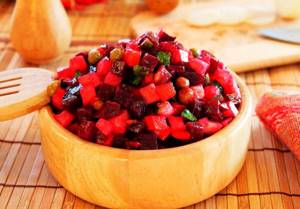
Every expectant mother worries about a sufficient supply of nutritional components that contribute to the successful development of the baby and maximum maintenance of her body. To do this, the diet includes not only fresh vegetables and fruits, but also a variety of salads. For example, many people are interested in whether pregnant women can have vinaigrette and how best to prepare it.
Is it possible for pregnant women to have vinaigrette?
A salad based on beets and potatoes is of great benefit to pregnant women. First of all, it helps prevent constipation, which often affects expectant mothers. Vegetable salad in the diet speeds up metabolism and stimulates peristalsis at all stages of pregnancy.
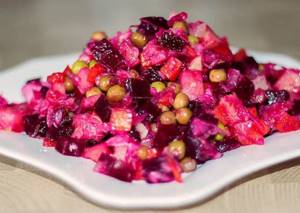
Vinaigrette supplies the body of a pregnant woman with the most important vitamins. Using the beneficial properties of vinaigrette, you can protect yourself from anemia and vitamin C deficiency. A cold snack is especially useful in winter, when there are fewer fruits and berries in the diet. Vegetable salad improves a woman’s immunity and helps prevent ARVI and influenza.
Tips for making a healthy salad
Expectant mothers are faced with various deviations in well-being, as a result of which there is a need to carefully think through the menu. When planning a pregnant woman’s diet in the second half of pregnancy, just as in all other cases, you need to take care of the proper preparation of your favorite dishes.
Vinaigrette does not have a generally accepted recipe. Despite this, it is important to focus on the basic ingredients. In this case, beets are required. Mushrooms, boiled fish, herring, a variety of seafood, lingonberries, meat, beans, green peas, apples, and tomatoes are traditionally added to the classic set of products.
Any available vinaigrette for pregnant women contains a large number of nutritional components and valuable vitamins that support the female body and the proper development of the unborn child.
Adding high-calorie mayonnaise, smoked fish, herring or meat with a high level of herring and nuts is undesirable. Otherwise, the dish will no longer be low-calorie.
Is it possible for a nursing mother to use vinaigrette?
During breastfeeding, vinaigrette can be a very useful element of the diet. It contains essential vitamins and minerals that will contribute to the rapid recovery of a woman’s body after childbirth. But at the same time, during lactation, vegetable salad should be consumed with special caution.
First of all, it is recommended to introduce cold snacks into the diet no earlier than 2-3 months after childbirth. Fiber, vitamin C and organic acids in the vinaigrette can harm the baby’s health and cause intestinal colic. It is recommended that nursing mothers use only well-boiled vegetables for vinaigrette; in this case, there will be less coarse dietary fiber in them.
When breastfeeding, it is strictly forbidden to add salted, pickled and pickled cucumbers and cabbage to the salad. Such ingredients contain a lot of digestive enzymes that increase gas formation, which will have a bad effect on the baby’s well-being. In addition, foods with a high salt content retain fluid in the body and prevent the outflow of milk.
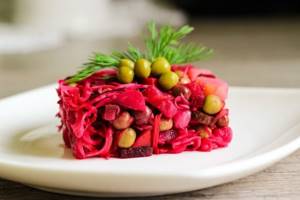
Canned peas and spices should not be added to the salad. A healthy vinaigrette for nursing mothers should consist only of fresh, high-quality vegetables that have undergone thorough heat treatment.
Beneficial effect on the female body
Vinaigrette is considered one of the healthiest salads for expectant mothers. It is this dish that allows you to obtain nutritional components from boiled vegetables that grew in a certain region. A large number of ingredients helps the salad become the most healthy dish.
Is vinaigrette good for pregnant women? The salad is allowed for consumption during pregnancy. This is due to the presence of macro-, microelements and vitamins. It is better to undercook vegetables than to overcook them. Otherwise, the beneficial properties will be lost, so support for the proper functioning of organs is excluded. Natural vinaigrette for pregnant women can be included on a regular basis due to its unique and multi-component composition.
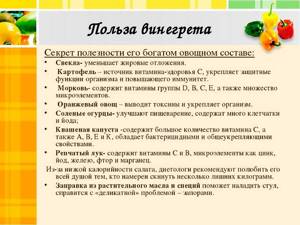
Useful properties of vinaigrette:
- Carotene from carrots improves vision;
- green pea glutamate supports mental activity;
- fiber in boiled vegetables guarantees the prevention of constipation;
- lactic acid in pickled cucumbers is required to protect against various viruses;
- betaine from beets helps prevent intestinal and liver cancer;
- vitamin P, which is contained in beets, is required for the elasticity and strength of vascular walls;
- beets renew liver cells and improve blood circulation;
- Boiled potatoes retain a significant portion of vitamin C, which has a positive effect on the immune system.
A multi-component and natural vinaigrette helps support the female body, which needs additional substances during an “interesting situation”.
The benefits of vinaigrette
The benefits of the salad ingredients are beyond doubt:
- carotene present in carrots helps strengthen vision;
- pickles contain quite a lot of lactic acid, which protects against the harmful effects of viruses;
- beets contain flavonoids that increase the elasticity of the walls of blood vessels. The vegetable activates the process of liver cell renewal;
- sauerkraut is rich in vitamins A, C and B. The product has bacteriostatic and tonic properties;
- Onions are rich in vitamin C, iodine, zinc, iron and manganese.
Important! The vegetables present in a delicious salad make up for the deficiency of minerals and vitamins in the body of a pregnant woman. These foods contain fiber, which prevents constipation.
Recipe
In order for the benefits of the vinaigrette to be manifested at the highest possible level, it is necessary to follow the preparation technology.
Recipe. The classic salad includes 600 grams of beets, 250 grams of carrots and potatoes, 4 pickles, a can of green peas, garlic, herbs, vegetable oil and sour cream. The traditional recipe for vinaigrette for pregnant women stipulates that all vegetables should be boiled and cut into small cubes, poured into a bowl. Then all components are thoroughly mixed. Green peas, squeezed garlic, and finely chopped greens are added to the salad.
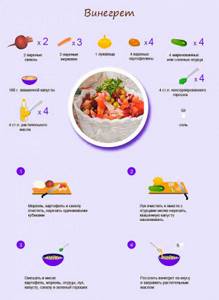
The ideal dressing is vegetable or olive oil. Proper nutrition in the first half of pregnancy involves not only the use of fresh vegetables, but also adherence to culinary technologies.
Vinaigrette, like other vegetable salads, turns out to be truly important for many pregnant women. Proper preparation of a dish allows you to expect to receive the maximum amount of components, as a result of which there is a positive effect on the functioning of many organs and the immune system.
Regular inclusion of healthy salads throughout pregnancy is the key to good nutrition for every expectant mother.
An old recipe for vinaigrette with herring
As you know, the very first vinaigrette was with herring and this salad came to us from the Scandinavian countries. But over time, herring was removed from the recipe because in those distant times, herring was hard to come by. And they left what was in abundance. That’s how this salad came to us without herring.
Today the problem with herring has been solved and why not prepare a vinaigrette in the original way, so to speak. Moreover, it is not so difficult.
You'll see how surprised your guests will be when they try an ordinary, familiar salad with a new ingredient.
- Fillet from one herring.
- 3-4 potatoes.
- 1 large beet.
- 2-3 carrots.
- 1 medium cucumber. (salty).
- 1 can 250 grams. peas
- Green onions and dill.
- Vegetable oil for dressing.
- Mustard for dressing.
- Black pepper and salt.
1. Naturally boil the vegetables and cool.
2.Chop vegetables and onions into small cubes.
6. Carrots, also in cubes.
7. Well, also diced herring fillet.
8.Place all chopped ingredients in a salad bowl.
9.In a small bowl, mix vegetable oil, mustard, black pepper and lemon juice. Mix lightly and season the salad. Taste for salt and add salt if necessary.
10. The herring vinaigrette is completely ready to serve and treat your guests to a bon appetit.
Nutrition during pregnancy
The fact that nutrition during pregnancy should be complete, balanced and healthy is not news. Everyone around you knows about this, including you, even if you have never been pregnant. But how to provide the expectant mother with the right diet is sometimes a real mystery. In the first trimester, a woman often cannot eat anything at all due to toxicosis tormenting her. Then she suddenly comes to her senses, but her taste preferences change dramatically: now her favorite dish is not pilaf or borscht, but smoked fish with chocolate and strawberry sauce. And three weeks before giving birth, she generally begins to eat everything without stopping.
The optimal amount of food consumed and the diet of a pregnant woman are separate topics. Let's just say that the daily calorie content of your diet should be 2300-3000 kcal. And it is imperative to maintain a balance of proteins, fats, carbohydrates, micro- and macroelements - no restrictive diets! The most appropriate would be a four-meal diet.
And now we’ll talk about what you can eat during pregnancy, what foods you should give preference to, so as not only not to harm the baby and yourself, but also vice versa: to get the greatest benefit from food during such an important period.
How to create a menu for a pregnant woman?
Vegetables and fruits must certainly be included in the daily diet of the expectant mother. If you don't have allergies, you can choose any of them. But it’s better to leave the exotic for later. It’s good if plant-based products make up 2/3 or at least half of your daily diet. Eat them raw and cooked, in salads, soups and main courses. Decoctions of dried fruits are very useful. Especially increase the amount of plant foods in the last weeks of the term. Vegetables and greens improve the elasticity of the tissues of the birth canal and help normalize intestinal function. In addition, extra pounds before childbirth are very undesirable, and such food will help maintain weight.
Berries are extremely healthy and desirable for a pregnant woman. You can and should eat a wide variety of berries. Prepare fruit drinks, compotes, souffles, eat fresh, frozen, dry, grated with sugar or in combination with other dishes (for example, in salads).
Meat should not be excluded from the diet under any circumstances. This is the main source of much-needed animal protein (along with fish and dairy products). Meat provides you with B vitamins and iron. Choose lean, chilled (rather than frozen) meat. But it is better to refrain from sausages with preservatives and dyes.
Fish is a source of phosphorus and vitamin D, which, by the way, are responsible for the functioning of the baby’s nervous system. Choose low-fat fish: cod, perch, pike, pollock, hake. And of course, it's better fresh. It is preferable to cook fish by boiling or baking.
Dairy products are the most complete and significant sources of calcium. Both fresh and fermented milk products are equally beneficial for a pregnant woman. A glass of kefir or yogurt will be an excellent option for a second dinner, and cottage cheese with sour cream for breakfast or an afternoon snack is not only healthy, but also tasty. However, be careful with whole milk - it contains a lot of allergenic protein. And any store-bought milk is whole milk. Therefore, it is better to drink it after boiling.
Is vinaigrette healthy?
Vinaigrette is one of the most common and popular salads, which is prepared only using boiled vegetables and boiled meat.
Despite the fact that such a salad made from boiled ingredients is considered the most budget-friendly option for a holiday dish, it is prepared with great pleasure for any celebration.
It is not only easy to prepare, but contains many useful substances. Plus it looks very attractive.
Useful properties of vinaigrette
Each component of this salad has its own beneficial and, to some extent, healing properties.
Thus, peas contain such important elements for the human body as vanadium, silicon, copper, manganese, molybdenum and cobalt. And in the composition of raw onions you can find another unique element - vitamin K.
This vitamin promotes better blood clotting, and it can only be found in the required quantities in this root vegetable.
A huge number of different important elements are contained in the most important component of the vinaigrette - beets. Beets contain, among other things, betaine, a natural coloring substance that protects the walls of blood vessels from damage by toxic substances.
Nutrients in vinaigrette
- Vitamins A, B, C, PP, etc.;
- Betacarotene;
- Cellulose;
- Iodine;
- Magnesium;
- Potassium;
- Calcium;
- Iron.
So vinaigrette is useful for everyone, without exception.
Is vinaigrette good for weight loss?
Did you know that the popular and once festive salad is the best dish for those who want to lose weight? This salad can also replace many vitamin complexes.
This salad of boiled vegetables has such a low calorie content that it will not be possible to acquire excess volumes even if the vinaigrette is consumed regularly and in large quantities.
All components included in it are low in calories, and it necessarily includes products such as canned green peas or beans, carrots, red beets, and boiled potatoes.
The most high-calorie ingredients are boiled beef or chicken meat and vegetable oil. Additionally, another important component is added to the vinaigrette, which is why the salad got its name - vinegar, which translated into French means “vinaigre”.
Some housewives, who know a lot about not only tasty, but also healthy food, try to make the vinaigrette even more healthy, and for this they replace pickled cucumbers with olives.
Such a replacement is not accidental, since olives contain more substances important for the body, for example, polyunsaturated fatty acids, but very little salt.
In addition, in the vinaigrette, you can replace boiled carrots with grated raw carrots, and you can additionally add diced green apple pulp.
Vinaigrette itself is an absolutely harmless product. Caution should be exercised only with sauerkraut and pickled cucumbers for certain diseases:
- gastritis with high acidity,
- peptic ulcer,
- kidney diseases.
How much vinaigrette can you eat?
Due to the fact that vinaigrette is a dish that contains almost all the necessary vitamins and many minerals, you can eat it without restrictions. But if you decide to eat it several times during the day, then limit the salted and fermented ingredients in it.
How to prepare vinaigrette
Despite the fact that root vegetables are boiled, you should not take spoiled, soft vegetables with signs of rotting. Sauerkraut or pickled cucumbers, onions are not recommended for use in baby food and for gastrointestinal diseases. As a last resort, it is better to rinse the sauerkraut thoroughly with water.
Vinaigrette is a dish where every housewife can express her culinary imagination. If you don’t like one of the ingredients or it is contraindicated, you can replace it.
Mushroom vinaigrette
Boil beets, potatoes and carrots. Chop the root vegetables and mix with vegetable oil and salt each separately. Boil mushrooms in salted water. Finely chop the onion and pour boiling water over it.
Layer all the ingredients: beets, carrots, potatoes, mushrooms, onions. Then potatoes, carrots, onions, beets, mushrooms. Sprinkle parsley on top.
Source: https://polezen-li.ru/polza-produktov-pitaniya/vinegret.html
What can I add?
There is no generally accepted recipe for vinaigrette, but there is a list of basic ingredients. An important point: beets are always present. Added to the classic set of products:
- mushrooms;
- boiled fish;
- lingonberries;
- chopped herring;
- boiled and smoked seafood;
- green peas (preferably boiled);
- beans;
- boiled meat or tongue;
- “Antonovka” apples (fresh or soaked);
- fresh tomatoes;
- fresh herbs;
- green onions.
If meat or fish is added, cabbage is excluded. Novice housewives need to remember this nuance so as not to spoil the holiday dish.
Cooking secrets
To enjoy the taste as much as possible, you need to know the secrets of making vinaigrette:
- Pre-baked vegetables have a richer flavor and are also healthier.
- You cannot use metal utensils that oxidize for salad.
- Do not mix warm and cold ingredients.
There are many recipes for making vinaigrette. The main ingredient of the dish is beets. Apples, tomatoes, herring, various seafood, and mushrooms are often added to the classic set of products. So what are the benefits of this dish while you are expecting a baby?
For those who count calories
Photo: Marina Konova.
Traditional vinaigrette is low-calorie: about 130 kcal per 100 g. However, changing the proportions of traditional products, including new ones, replacing the dressing - all this affects the total calorie content of the dish.
Let me give you an example. If medium-sized beets, carrots and potatoes (3 pieces each) are placed in a sleeve and baked in an air fryer, add 400 g of green peas, 2 fresh and pickled cucumbers, 2 tbsp. l. vegetable oil, you get a low-calorie salad: only 62 kcal per 100 g.
Let's change the proportions. If you boil 300 g of carrots, 150 g of potatoes, 400 g of beets, cut 100 g of pickles, mix with 200 g of boiled beans and 50 g of vegetable oil, the calorie content of the vinaigrette will be: 92 kcal per 100 g.
The options from the example can be considered dietary, since their moderate consumption does not harm the figure.
Adding high-calorie mayonnaise, meat, smoked fish, fatty herring, and nuts will immediately remove vinaigrette from the list of low-calorie dishes. Be careful with vegetable oil! Calorie content 1 tbsp. l. comparable to the calorie content of a pack of cottage cheese or 120 g of boiled veal. In addition, our body accumulates some fats in reserve.
Chemical composition of vinaigrette
There are a lot of recipes for making vegetable salad. But the classic vinaigrette consists of the following products:
- potatoes;
- beets;
- carrots;
- cucumbers;
- onions and green peas;
- oils and salt.
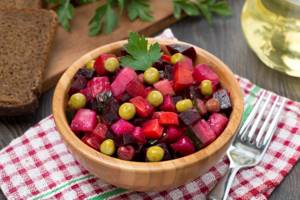
The components of the cold snack provide it with a rather rich chemical composition.
The salad contains:
- B vitamins;
- nicotinic acid PP;
- vitamin K;
- ascorbic acid;
- cellulose;
- phosphorus and iron;
- beta-carotene;
- potassium and magnesium;
- calcium and iodine;
- starch.
In a classic vinaigrette, fats occupy about 10.3 g, while proteins and carbohydrates account for 1.7 and 8.2 g, respectively. 100 g of vegetable dish contains about 130 kcal.
Why is it useful?
Winter and spring are the best time for vinaigrette. Thanks to this dish, we can get the necessary nutrients from boiled vegetables grown in our region. The multi-component composition of Russian salad makes it the most healthy dish:
- Carotene from carrots protects the mucous membrane of the eyes;
- green pea glutamate supports mental activity;
- vegetable fiber prevents constipation and prevents heart attack;
- lactic acid in pickles protects against viruses;
- betaine from beets provides prevention of intestinal and liver cancer;
- beet flavonoids (vitamin P) help increase the elasticity and strength of vascular walls;
- beet pulp helps get rid of stomach ulcers;
- beets promote the renewal of liver cells and improve blood circulation;
- the low calorie content of the vinaigrette helps you avoid gaining extra pounds;
- vitamins contained in potatoes normalize high acidity;
- potatoes cooked in their jackets retain a significant portion of vitamin C;
- vegetables in the vinaigrette replenish the deficiency of vitamins and minerals in the winter-spring period.
Vinaigrette can and should be consumed during pregnancy. Vitamins, minerals and vegetable fiber will provide the mother’s body (and, accordingly, the fetus) with the necessary elements and help avoid constipation.
Contraindications to vinaigrette
There are few strict prohibitions on consumption of vegetable salad. Among them are:
- gout and urolithiasis, as well as kidney stones;
- gastric ulcer and pancreatitis in a state of exacerbation;
- acute gastritis with high acidity;
- individual intolerance to individual salad components;
- tendency to frequent digestive disorders.
It is better not to eat salad if you have diabetes; beets and potatoes have a high glycemic index.
Healthy Supplements
Photo: Marina Konova.
Lately there has been a lot of talk about the dangers of potatoes. If potatoes form the basis of the diet, then there is more harm than good. It is recommended to consume no more than 200 g of this tuber per day.
It is better to undercook vegetables than to overcook them. When overcooked, they lose their beneficial properties of normalizing stool, and their carbohydrates, broken down into simple chains, are completely absorbed. Result: more sugars consumed, higher appetite, less benefits.
It is advisable to steam or bake potatoes and beets - this makes it easier to preserve water-soluble vitamins in the vegetables.
Potential Harm
Vinaigrette has few harmful properties, but excessive use of it is dangerous for the body.
- People with osteoporosis are advised to include beets in their diet with caution.
- The high sugar content of beets makes them an unsafe food for diabetics.
- Oxalic acid, contained in the key root vegetable of vinaigrette, is dangerous for people with urolithiasis.
- Sauerkraut will cause discomfort in people suffering from colitis, peptic ulcers, and gastritis.
- Individual intolerance to salad components can become dangerous for someone.
When including vinaigrette in your diet, you must not forget about the pros and cons of this dish. But you can come up with your own recipe, replacing not very healthy ingredients with others, or adding something new. For example, if you don't like potatoes, let boiled beans take their place. And don’t forget fresh herbs, green onions, tomatoes - these ingredients are largely responsible for the taste of beet salad.
Avoid using canned vegetables in this recipe. It is also better to replace sauerkraut with fresh cabbage, salt with lemon juice, and pickles with Antonov apples.
The harm of vinaigrette
For all its beneficial properties, salad can be harmful if consumed incorrectly. Moreover, the harm directly depends on the composition of the dish prepared according to a specific recipe:
- The high content of beets in salad can be dangerous for people suffering from osteoporosis. Beetroot is also harmful if you are prone to diarrhea; it has a pronounced laxative effect.
- Beets contain quite a lot of sugar. This makes the classic salad dangerous for diabetics; when consuming it, sharp fluctuations in glucose levels can occur.
- Beetroot contains oxalic acid. In small quantities it is necessary for the body, but with gout and stones in the kidneys and bladder, eating salad becomes harmful.
- The benefits of vinaigrette with sauerkraut or pickles are not always unconditional. This snack stimulates digestion, but can provoke an exacerbation of gastritis, peptic ulcers or intestinal colitis.
Subtleties of cooking
- Baked vegetables will make the salad tastier and healthier.
- If you don't like brightly colored foods, start putting vegetables with chopped beets in a container, after pouring oil on them.
- Do not use metal utensils that oxidize.
- Do not add a lot of oil - the food should not “float” in it.
- To prevent the salad from turning sour quickly, do not mix hot and cold ingredients.
- Pre-squeeze excess brine from cucumbers.
- First salt, then oil.
- Don't cut the ingredients too small or too large.
- Remember: unrefined oil is healthier.
- Do not store the vinaigrette for more than a day.
Vinaigrette is a delicious dish, but only you can make it truly healthy. Take action!
Subtleties of making a dish
In order for the taste of the dish to be more pleasant and rich, you must adhere to the following recommendations:
- You can add baked vegetables to the dish;
- when preparing salad, do not use metal utensils, which are easily oxidized;
- when preparing vinaigrette, you can replace potatoes with Jerusalem artichoke;
- It is not recommended to add a large amount of vegetable oil to the vinaigrette. The dish can be seasoned with unrefined oil. This product contains a large amount of vitamin E and polyunsaturated acids. These substances facilitate the absorption of fat-soluble vitamins, which are present in carrots and some other foods;
- You can add both fresh and soaked apples to the vinaigrette;
- Do not mix hot and cold ingredients. In this case, the salad may quickly turn sour;
- When preparing a vinaigrette, you can replace canned foods (beans and green peas) with fresh vegetables. They must first be boiled until cooked.
The finished vinaigrette should not be stored for more than 24 hours.
